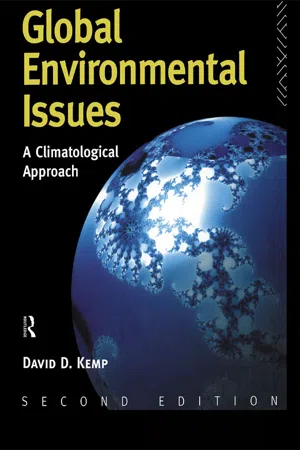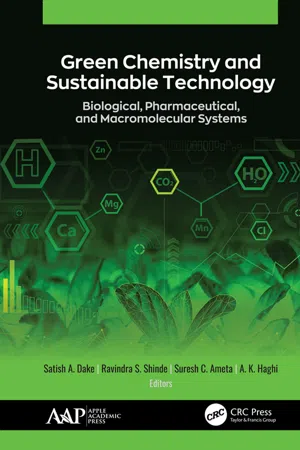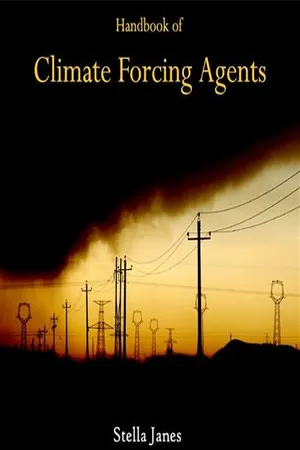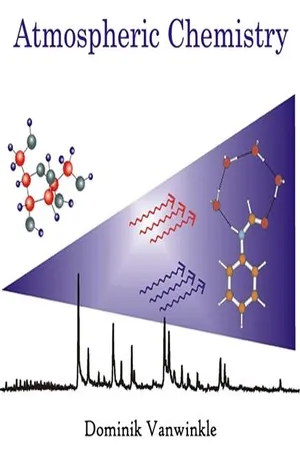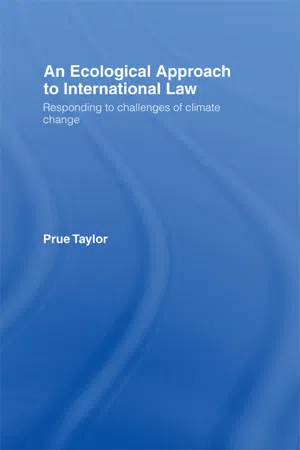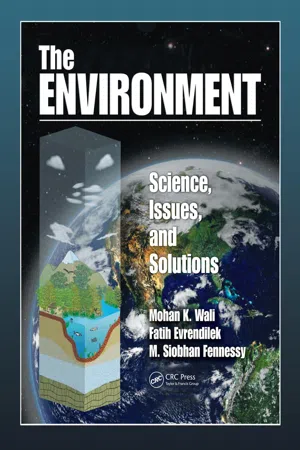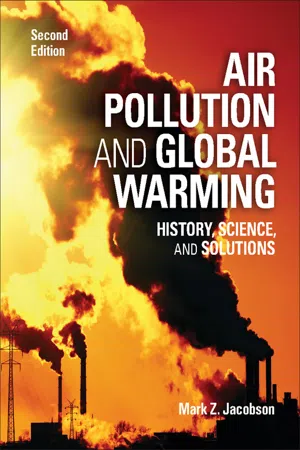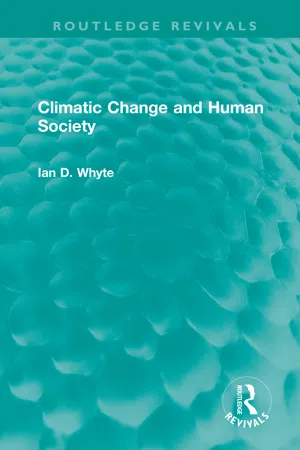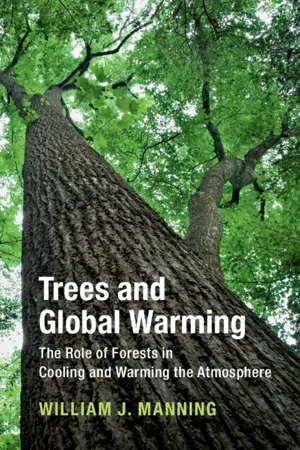Technology & Engineering
Greenhouse Effect
The greenhouse effect refers to the process by which certain gases in the Earth's atmosphere trap heat from the sun, leading to an increase in the planet's temperature. This natural phenomenon is essential for maintaining a habitable climate on Earth. However, human activities, such as the burning of fossil fuels, have intensified the greenhouse effect, contributing to global warming and climate change.
Written by Perlego with AI-assistance
Related key terms
1 of 5
12 Key excerpts on "Greenhouse Effect"
- eBook - ePub
Greenhouse Economics
Value and Ethics
- Clive Spash(Author)
- 2020(Publication Date)
- Routledge(Publisher)
2 Scientific understanding of the enhanced Greenhouse EffectThe Greenhouse Effect refers to the phenomenon whereby carbon dioxide and other gases trap long-wave infrared radiation (heat) within the lower levels of the atmosphere. Those gases, such as carbon dioxide (CO2 ), nitrous oxide (N2 O), certain chlorofluorocarbons (CFCs), methane (CH4 ), tropospheric ozone (O3 ) and water vapour, that are transparent to solar radiation but opaque to long-wave radiation, are termed greenhouse gases (GHGs). Increasing the concentration of greenhouse gases reduces the amount of long-wave radiation returning directly into space, causing reradiation of some of the heat energy back to Earth’s surface, and so results in raised temperatures in the lower atmosphere. This process enhances the natural Greenhouse Effect.The Greenhouse Effect is one of the better understood features of the atmosphere. In the early nineteenth century, the French mathematician Fourier speculated that certain atmospheric gases might prevent reradiation of heat, so warming the surface of the Earth (Jamieson, 1988). Since the work of John Tyndall, circa 1861, water vapour and carbon dioxide have been recognised as radiative absorbers affecting climate (Idso, 1982). Surface warming due to the greenhouse gases maintains a liveable climate, and their entire removal from the atmosphere (if possible) would reduce Earth’s surface temperature by 33°C (Firor, 1989). However, the operation of this radiative balance mechanism has become a matter of concern because of the rate at which anthropogenic emissions of GHGs are increasing and the long residence times of some of these gases. Anthropogenic emissions of CO2 from fossil fuel combustion were hypothesised as climate-altering at the end of the last centur y. Arrhenius (1896) estimated that a doubling of CO2 would cause 4.9–6.1°C increase in continental surface air temperature depending upon latitude and season. He made calculations for reduced CO2 levels and for increases by 1.5, 2.0, 2.5 and 3.0 times then present levels. While modern understanding is far more detailed, and the estimates of Arrhenius are at the upper end of current predictions (1.4°C–5.8°C under TAR), the general points from over a century ago remain correct. For example, Arrhenius noted warming would be greater in winter and in the higher latitudes, and also that these differentials would change with the amount of CO2 - eBook - ePub
Global Environmental Issues
A Climatological Approach
- David Kemp(Author)
- 2002(Publication Date)
- Routledge(Publisher)
fait accompli. There are only a few dissenting voices, expressing misgivings about the nature of the evidence and the rapidity with which it has been embraced. A survey of environmental scientists involved in the study of the earth’s changing climate, conducted in the spring of 1989, revealed that many still had doubts about the extent of the warming. More than 60 per cent of those questioned indicated that they were not completely confident that the current warming was beyond the range of normal natural variations in global temperatures (Slade 1990).THE CREATION OF THE Greenhouse Effect
The Greenhouse Effect is brought about by the ability of the atmosphere to be selective in its response to different types of radiation. The atmosphere readily transmits solar radiation— which is mainly short-wave energy from the ultraviolet end of the energy spectrum—allowing it to pass through unaltered to heat the earth’s surface. The energy absorbed by the earth is reradiated into the atmosphere, but this terrestrial radiation is long-wave infrared, and instead of being transmitted it is absorbed, causing the temperature of the atmosphere to rise. Some of the energy absorbed in the atmosphere is returned to the earth’s surface, causing its temperature to rise also (see Chapter 2 ). This is considered similar to the way in which a greenhouse works— allowing sunlight in, but trapping the resulting heat inside—hence the use of the name ‘Greenhouse Effect’. In reality it is the glass in the greenhouse which allows the temperature to be maintained, by preventing the mixing of the warm air inside with the cold air outside. There is no such barrier to mixing in the real atmosphere, and some scientists have suggested that the processes are sufficiently different to preclude the use of the term ‘Greenhouse Effect’. Anthes et al - eBook - ePub
Green Chemistry and Sustainable Technology
Biological, Pharmaceutical, and Macromolecular Systems
- Satish A. Dake, Ravindra S. Shinde, Suresh C. Ameta, A. K. Haghi, Satish A. Dake, Ravindra S. Shinde, Suresh C. Ameta, A. K. Haghi(Authors)
- 2020(Publication Date)
- Apple Academic Press(Publisher)
CHAPTER 12 Study on the Effect of Global Warming and Greenhouse Gases on Environmental System ONKAR K. JOGDAND Department of Environmental Science, Deogiri College, Station Road, Aurangabad – 431005, Maharashtra, India, E-mail: [email protected] ABSTRACT The Greenhouse Effect is a prominent influence in observance the Earth warm for the reason that it keeps some of the planet’s warmth that would otherwise seepage from the atmosphere out to space. The homework explosion on the Greenhouse gases (GHGs) and their impression on Global warming. Without the Greenhouse Effect, the Earth’s average global temperature would be much cooler and life on Earth as we distinguish it would be intolerable. GHGs include water vapor, CO 2, methane, nitrous oxide (N 2 O) and additional gases. Carbon dioxide (CO 2) and other GHGs turn like a comprehensive, gripping Infra-Red radiation. Worldwide warming is a significant environmental issue which is rapidly attractive a part of well-liked civilization. This manuscript provides an explanation of the science linked with this important issue. Past evidence for long-ago climate change is deliberated. The dissimilarity between climate and weather is highlighted. The physics of the greenhouse consequence and the perception of GHGs are presented. The concepts of radioactive forcing of climate change and worldwide warming latent as measures of the complete and relative strengths of GHGs are discussed. Global warming, the improvement of the natural Greenhouse Effect caused by emissions linked with person behavior of GHGs such as carbon dioxide, nitrous oxide, methane, and halogenated compounds (e.g., CFCs, and SF6), is described. Techniques used to representation history, present, and prospect climate are discussed. The models are based upon essential well recognized technical principals and incorporate the existing thoughtful of the multifaceted comment and couplings among the atmosphere, hydrosphere, and biosphere - eBook - ePub
Our Energy Future
Resources, Alternatives and the Environment
- Christian Ngo, Joseph Natowitz(Authors)
- 2016(Publication Date)
- Wiley(Publisher)
The energy absorbed by Earth’s atmosphere is absolutely critical to life as we know it. Without this absorption the average surface temperature on our planet would be very cold (−18°C). Water would not normally exist in liquid form, and life could not have developed in the same way as it has. Fortunately, our atmosphere contains gases known as greenhouse gases, which, though present in small quantities, are largely transparent to the incident direct solar radiation but capable of absorbing the energy emitted from Earth’s heated surface. This energy is emitted in all directions as longer wavelength infrared radiation. Absorption of Earth’s infrared radiation increases the average temperature from −18 to +15°C, making our planet a comfortable place to live. The result is very similar to that employed in greenhouses to grow plants. The greenhouse windows are transparent to visible solar radiation (so solar energy goes in), but absorbed energy reemitted from the soil or other objects located inside the greenhouse remains trapped and increases the internal temperature. Because the atmosphere serves both as a window to admit solar radiation and an absorber to trap part of the reemitted infrared radiation, the subsequent warming effect is known as the “Greenhouse Effect.”The first suggestion of the existence of the Greenhouse Effect was made in 1827 by Joseph Fourier, a French mathematician and physicist. He advanced the idea that Earth’s temperature was much greater than that of free space because the atmosphere acted to confine additional heat, functioning much like a garden greenhouse. In 1895, the Swedish chemist Svante Arrhenius was the first to calculate quantitatively the effect that an increase of CO2 concentration could have on atmospheric temperature. He predicted a global warming as a consequence of using fossil fuels and estimated that doubling the CO2 concentration would increase Earth’s average temperature by 5–6 C.Presently, there is growing concern that increasing greenhouse gas concentrations may adversely impact Earth’s climate. A significant part of this increase in greenhouse gases results from human activities, notably the combustion of fossil fuels—coal, oil, and gas. Since these fossil fuels are essential to the present world economy and currently meet about 80% of the world’s energy demand, a major reduction in their use is not feasible unless good energy source replacements are in place. In this chapter we quickly review the nature of the greenhouse gas emission problem and discuss current assessments of the impact that continued use of fossil fuels may have on the climate. - No longer available |Learn more
- (Author)
- 2014(Publication Date)
- Library Press(Publisher)
____________________ WORLD TECHNOLOGIES ____________________ Chapter- 4 Greenhouse Gas Simple diagram of Greenhouse Effect A greenhouse gas (sometimes abbreviated GHG ) is a gas in an atmosphere that absorbs and emits radiation within the thermal infrared range. This process is the fundamental cause of the Greenhouse Effect. The primary greenhouse gases in the Earth's atmosphere are water vapor, carbon dioxide, methane, nitrous oxide, and ozone. In the Solar System, the atmospheres of Venus, Mars, and Titan also contain gases that cause Greenhouse Effects. Greenhouse gases greatly affect the temperature of the Earth; without them, Earth's surface would be on average about 33 °C (59 °F) colder than at present. Since the beginning of the Industrial revolution, the burning of fossil fuels has increased the levels of carbon dioxide in the atmosphere from 280ppm to 390ppm. Unlike other ____________________ WORLD TECHNOLOGIES ____________________ pollutants, carbon dioxide emissions do not result from inefficient combustion: CO2 is a product of ideal, stoichiometric combustion of carbon. The emissions of carbon are directly proportional to energy consumption. Greenhouse Effects in Earth's atmosphere Modern global anthropogenic Carbon emissions In order, the most abundant greenhouse gases in Earth's atmosphere are: • water vapor • carbon dioxide • methane • nitrous oxide • ozone • chlorofluorocarbons The contribution to the Greenhouse Effect by a gas is affected by both the characteristics of the gas and its abundance. For example, on a molecule-for-molecule basis methane is about eighty times stronger greenhouse gas than carbon dioxide, but it is present in much smaller concentrations so that its total contribution is smaller. When these gases are ranked by their contribution to the Greenhouse Effect, the most important are: - No longer available |Learn more
- (Author)
- 2014(Publication Date)
- Learning Press(Publisher)
________________________ WORLD TECHNOLOGIES ________________________ Chapter 3 Greenhouse Gas Simple diagram of Greenhouse Effect. A greenhouse gas (sometimes abbreviated GHG ) is a gas in an atmosphere that absorbs and emits radiation within the thermal infrared range. This process is the fundamental cause of the Greenhouse Effect. The primary greenhouse gases in the Earth's atmosphere are water vapor, carbon dioxide, methane, nitrous oxide, and ozone. In the Solar System, the atmospheres of Venus, Mars, and Titan also contain gases that cause Greenhouse Effects. Greenhouse gases greatly affect the temperature of the Earth; without them, Earth's surface would be on average about 33 °C (59 °F) colder than at present. Since the beginning of the Industrial revolution, the burning of fossil fuels has subst-antially increased the levels of carbon dioxide in the atmosphere. ________________________ WORLD TECHNOLOGIES ________________________ Greenhouse Effects in Earth's atmosphere Modern global anthropogenic Carbon emissions. In order, the most abundant greenhouse gases in Earth's atmosphere are: • water vapor • carbon dioxide • methane • nitrous oxide • ozone • chlorofluorocarbons The contribution to the Greenhouse Effect by a gas is affected by both the characteristics of the gas and its abundance. For example, on a molecule-for-molecule basis methane is about eighty times stronger greenhouse gas than carbon dioxide, but it is present in much smaller concentrations so that its total contribution is smaller. When these gases are ranked by their contribution to the Greenhouse Effect, the most important are: ________________________ WORLD TECHNOLOGIES ________________________ Gas Formula Contribution (%) Water Vapor H 2 O 36 – 72 % Carbon Dioxide CO 2 9 – 26 % Methane CH 4 4 – 9 % Ozone O 3 3 – 7 % It is not possible to state that a certain gas causes an exact percentage of the Greenhouse Effect. - eBook - ePub
An Ecological Approach to International Law
Responding to the Challenges of Climate Change
- Prue Taylor(Author)
- 2008(Publication Date)
- Routledge(Publisher)
4The Greenhouse Effect is a natural phenomenon.5 Small amounts of trace gases are present in the earth's atmosphere. These gases are largely transparent to sunlight (short wave visible solar radiation), which warms the earth's surface. However, they absorb the longer wave infra-red radiation (heat) radiated by the earth and therefore act as a heat trap. As a consequence of this natural Greenhouse Effect6 the atmosphere and the earth's surface is warmed and maintained at a global average temperature of 15°C. Without it the global temperature would be about -20°C.7Water vapour, carbon dioxide and clouds are responsible for 90 per cent of the total natural Greenhouse Effect, with tropospheric ozone, methane and nitrous oxide comprising the remaining 10 per cent. Although these trace gases make up only a small fraction of the atmosphere,8 they provide the earth with a climate which can sustain life. The level of all these components is kept in delicate balance by the complex of the biosphere.Over the last few centuries the activities of humanity have begun to upset this delicate balance by both increasing the amount of trace gases in the atmosphere and interfering with the biotic mechanisms which maintain the balance. In short, increasing world population and rapid industrialisation have led to increased demand for energy, food and new technology. In response humanity burns large amounts of fossil fuels, deforests large tracts of land, practices intensive forms of agriculture, produces vast amounts of waste and produces and uses large amounts of synthetic chemicals, such as chlorofluorocarbons (‘CFCs’). In the view of the World Climate Research Programme, ‘for the first time in history, human activities have reached the stage where they affect climate on regional and global scales’.9 - eBook - PDF
The Environment
Science, Issues, and Solutions
- Mohan K. Wali, Fatih Evrendilek, M. Siobhan Fennessy(Authors)
- 2009(Publication Date)
- CRC Press(Publisher)
387 Topics Introduction Greenhouse Gases and the Greenhouse Effect Geological History and Temperature Carbon Dioxide and Temperature Evidence of Carbon Dioxide Increase Sources and Sinks of Carbon Other Greenhouse Gases Evidence of Global Warming General Circulation Models Climate–Weather Uncertainties Response of Biota to Climate Change Climate Change and Human Health Recent National and International Responses 19 The Greenhouse Effect and Climate Change Introduction During the 1970s and early 1980s, debates on environmental issues were largely concentrated on air and water pollution and the effects of acid rain on lakes and terrestrial ecosystems. The concerns, as we studied in the last chapter, were serious and the effects involved local, regional, and transboundary pollution into neighboring nation-states. Lurking not too far from this environ-mental scenario was yet another effect that some of these gases might have on the global climate as a whole. This involved less infrared radiation leaving the troposphere and thus the retention of greater amounts of heat in the Earth’s atmosphere. A perusal of the scientific literature shows that the effects of such a phenome-non—that is, heat retention by gases—were mentioned as early as 1827 by the Frenchman Jean-Baptiste Fourier. It was Fourier who introduced the concept of Greenhouse Effect to identify the natu-ral processes whereby the Earth sustains a heat balance. Later, the Swedish chemist Svante Arrhenius in the 1890s wrote specifically on the role of carbon dioxide, as did Roger Revelle at the Scripps Institution of Oceanography in 1957. (For an excellent narrative, read The Discovery of Global Warming by Spencer Weart, 2003.) Greenhouse Gases and the Greenhouse Effect The term “Greenhouse Effect” came into vogue because the atmo-sphere bears a similarity in trapping heat to a glass greenhouse. In the absence of any Greenhouse Effect, the Earth’s average surface temperature would be 33°C colder. - eBook - PDF
- Singh, M P(Authors)
- 2021(Publication Date)
- Daya Publishing House(Publisher)
2004). Greenhouse Effect The Greenhouse Effect is best described in terms of the annual global average radiative energy budget of the Earth-atmosphere system. The Earth-atmosphere system radiates about 236 Wm –2 (long-wave radiation) to space. This amount balances the incoming short-wave radiation from the sun. at a temperature of 15°C, the Earth’s surface radiates about 390 Wm –2 . The reduction of the long-wave radiation to space as a result of the intervening atmosphere is referred to as the Greenhouse Effect. The most important atmospheric constituents contributing to the Greenhouse Effect are water vapour, carbon dioxide, and clouds. Without the Greenhouse Effect, but with the same amount of incoming solar radiation and the same albedo, the global average surface temperature would be about-19°C. With GHGs in the atmosphere, the longwave radiation from the Earth’s surface is partly absorbed and then re-emitted by the gases at the temperature of the air at their level. This has the effect of raisign the effective emitting level to several km above the surface where the temperature is about 30°C lower than near the Earth’s surface. So, the Earth’s surface temperature can be higher by about this amount (the global average surface temperature is about 15°C). The Earth and atmosphere together emit the same amount of radiation to space as in the absence of greenhouse gases (GHGs). In recent years, this balance has been disturbed by the addition of GHG's to the atmosphere. An increase in the atmospheric concentration of a GHG's, changes the radioactive energy balance, which increases the temperature of the Earth’s surface and lower atmosphere, and decreases the temperature in the upper atmosphere. - eBook - PDF
Air Pollution and Global Warming
History, Science, and Solutions
- Mark Z. Jacobson(Author)
- 2012(Publication Date)
- Cambridge University Press(Publisher)
12.1. Temperature on Earth in the Absence of a Greenhouse Effect The natural Greenhouse Effect is the warming of the Earth’s troposphere due to an increase in natural green-house gases. Greenhouse gases are gases that are largely transparent to the sun’s visible radiation but absorb and reemit the Earth’s thermal-IR radiation at selective wavelengths. They cause a net warming of the Earth’s atmosphere similar to the way in which a glass house causes a net warming of its interior. Because most incoming solar radiation can penetrate a glass house but a portion of outgoing thermal-IR radiation cannot, air inside a glass house warms during the day as long as mass (e.g., plant mass) is present within the house to absorb the solar radiation, to heat up the air, and to reemit thermal-IR radiation. The surface of the Earth, like plants, absorbs solar radiation and reemits thermal-IR radiation. Greenhouse gases, like glass, are transpar-ent to most solar radiation but absorb a portion of the Earth’s thermal-IR radiation at selective wavelengths. Global warming is the increase in the Earth’s temperature above that from the natural Greenhouse Effect due to the addition of anthropogenically emit-ted greenhouse gases and aerosol particle components that directly absorb solar radiation. Important absorb-ing aerosol particle components include black car-bon (BC) and certain organic carbon compounds, 264 collectively referred to as brown carbon (BrC) . BC absorbs across the entire solar spectrum. BrC strongly absorbs UV and short visible wavelengths of light, but not solar-IR wavelengths (Chapter 7). Because parti-cles containing BC and BrC contain some nonwarming components but predominantly cause warming, they are referred to as warming particles . - eBook - ePub
- Ian D. Whyte(Author)
- 2021(Publication Date)
- Routledge(Publisher)
3
The Greenhouse Effect and Greenhouse Gases
DOI: 10.4324/9781003173496-3Although it is assumed that readers have some background knowledge of the workings of the climate system, a few points need to be emphasised before looking at the Greenhouse Effect in detail. To understand how climate works, the atmosphere cannot be considered alone; the other environmental systems with which it is linked or coupled must also be taken into account (Fig. 3.1 ). Climate is the result, not only of complex sets of interactions within the atmosphere, but also between the atmosphere and the oceans, land surfaces and their vegetation, and snow and ice cover. Together these form the climate system. The Earth’s climate is driven by energy from the Sun. The temperature of the Earth adjusts itself to maintain a balance between incoming and outgoing radiation but this balance can be altered by various forcing factors, the intervention of which can cause a readjustment of temperatures which can, in turn, affect the entire climate system. Changes in the amount of solar radiation received by the Earth, or variations in its seasonal distribution due to orbital changes, are two forcing factors. As discussed in Chapter 2 , changes in the Earth’s orbit are likely to have been a background cause of ice ages. There is currently considerable debate about the amount of variability of solar radiation on shorter time-scales and the effect that such changes may have on climate. Records of solar irradiance from satellite monitoring suggest that the amount of variation is only around 0.1 per cent, insufficient to have a significant effect on climate. However, such measurements have only been available for a few years and the possibility of longer-term variations which might have a greater impact on climate cannot be dismissed (Schonwiese et al., 1994).Fig. 3.1 - eBook - PDF
Trees and Global Warming
The Role of Forests in Cooling and Warming the Atmosphere
- William J. Manning(Author)
- 2020(Publication Date)
- Cambridge University Press(Publisher)
The Gases That Cause the Greenhouse Effect [N]on-condensing greenhouse gases provide the temperature environment that is necessary for water vapor and cloud feedback effects to operate. . . .Because carbon dioxide accounts for 80% of the non- condensing GHG forcing in the current climate atmosphere, atmospheric carbon dioxide therefore qualifies as the principal control knob that governs the temperature of the Earth. Lacis et al., 2010, commenting on Schmidt et al., 2010 . The nature of global warming and climate change was introduced in Chapter 1. This chapter considers in detail the Greenhouse Effect and the reactive gases that cause it. The sun plays the key role in the energy balance of the Earth. The proximity of the sun to the Earth makes life on Earth possible. Shortwave and ultraviolet energy from the sun enters the atmosphere during the day; the visible part is known as sunlight. Not all of it reaches the surface of the Earth. Clouds can reflect incoming radiation back to space. Suspended aerosols and reflection (albedo) from light- colored surfaces such as ice and snow are also effective in reflecting incoming radiation: as much as 50% may be reflected, and even more on cloudy days. Beginning during the day and continuing into the night, some of the incoming radiation absorbed by the Earth returns to space in the form of long wave infrared radiation, but some is trapped down below low clouds and suspended aerosols. Atmospheric gases, such as water vapor, carbon dioxide, methane, nitrous oxide, ozone, and synthetic chloro- and fluorocarbon gases, also absorb and emit infrared radiation. Retention of infrared radiation increases the air and surface temperature of the Earth. This is the natural essential Greenhouse Effect. Without it, the Earth would be too cold at night to support life (Jacobson, 2002; Karl and Trenberth, 2003; Prentice et al., 2012).
Index pages curate the most relevant extracts from our library of academic textbooks. They’ve been created using an in-house natural language model (NLM), each adding context and meaning to key research topics.

